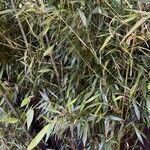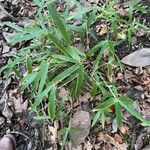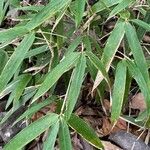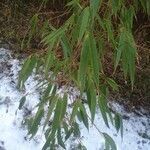Open thicket-forming with rhizomes running extensively. Culm 4-7 m (often much taller in cultivation), green, remaining so or becoming black or heavily blotched black in 2nd year, erect, with white waxy ring beneath nodes when young; nodes all ± evenly spaced. Culm-sheaths uniformly purple or purple-flushed, sometimes dark blotched above; auricles on main shoots prominent, dark; oral bristles long, caducous; sheath-blade linear, undulate. Branches green or black, spreading widely (giving an open network). Leaf-sheath with very short auricles. Oral bristles present. Leaf-blade usually 5-9-(13)× 0.5-2-(3) cm, lanceolate, abaxially glaucescent, adaxially moderately shining, acuminate.
Culms 3–6 m high, 1–2 cm diam., brownish or purplish black at maturity; mid-culm internodes short, 1.4–2.5 cm long, sparsely to densely pubescent to pilose but becoming glabrous with age with a white bloom particularly below nodes. Culm leaves auriculate, with auricles bristled; blade triangular to lanceolate, usually bent outward, slightly wavy-wrinkled. Foliage leaves auriculate, with auricles prominently bristled; blade lanceolate, 7–10 cm long, 9–15 mm wide, flat, abaxially glabrous except for hairs fringing midrib near base and extending to petiole, scabrous to hirsute on margins.
A large bamboo grass. It grows 1.5-3 m high and spreads 1.8-3 m wide. It can be 10-15 m tall and spread 6-15 m wide. It forms clumps. The canes arch over. The canes are green in the first year then turn mottled to almost black. The canes are hollow and can be 3 cm thick.




